Below are the top takeaways from the Home Builders Institute’s Spring 2023 HBI Construction Labor Market Report: 1. The U.S. faces a shortage of 1.5 million homes which, as a matter of supply and demand, forces rents and house prices higher nationwide. 2. The construction industry currently needs approximately 723,000 new construction workers each year to meet Read more
Industry News
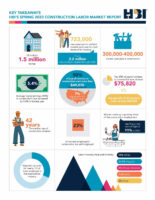
Below are the top takeaways from the Home Builders Institute’s Spring 2023 HBI Construction Labor Market Report:
1. The U.S. faces a shortage of 1.5 million homes which, as a matter of supply and demand, forces rents and house prices higher nationwide.
2. The construction industry currently needs approximately 723,000 new construction workers each year to meet demand (residential construction represents 3.2 million of the construction payroll employment of 7.9 million).
3. The number of open construction sector jobs currently averages between 300,000 to 400,000 every month.
4. At least 90 percent of single-family builders responding to a survey reported a shortage of carpenters, and 80 to 85 percent reported a shortage of subcontractors in six other trades. More than 80 percent of remodelers reported a shortage of subcontractors in 11 of the 16 trades.
5. The share of Americans who choose to stay out of the labor force stands at a historical low. The labor force participation rate for people aged between 25 and 54 is 83 percent.
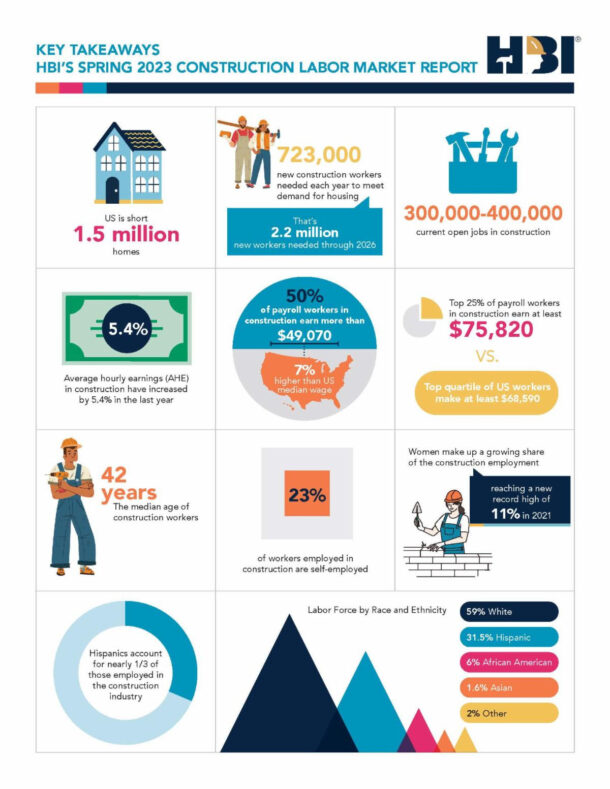
6. The share of construction workers aged 25 to 54 dropped by six percent over the past seven years.
7. Hourly wages in construction are higher than in other industries. The average hourly earnings in construction have increased 5.4 percent since a year ago, now approaching the $36 mark. The average hourly earnings in manufacturing is $31.80; in trade, transportation and utilities it is $27.67. Overall, in the private sector: $33.20.
8. The share of women in construction stands at 11 percent. While that is a new record high, gains have been persistently slow, rising by less than two percent in four years.
9. The share of Hispanics employed in the construction industry is 31.5 percent in 2021 (most recent available data). That compares to an 18.8 percent share of Hispanics across all industries. Non-Hispanic Whites account for 59 percent in the construction industry, about the same as across all industries (59.6 percent). Blacks and Asians are underrepresented in the construction industry.
10. Concentration of immigrants is high in many of the trades needed to build a home. For example: plasterers and stucco masons (56 percent), drywall/ceiling tile installers (52 percent), roofers (48 percent), painters (47 percent), carpet/floor/tile installers (43 percent), and construction laborers (38 percent).
According to Ed Brady, President and CEO of the Home Builders Institute (HBI), the facts show the construction industry today must focus on three urgent priorities for the country:
1) promote training and jobs in the trades to those people who have not yet considered a career in construction;
2) support immigration reform designed to produce the next generation of New Americans seeking opportunity in the United States;
3) advocate for housing affordability by demonstrating the direct link between the nation’s housing shortage and its construction labor shortage.
For more information and to download the report, click Spring 2023 HBI Construction Labor Market Report
The Home Builders Institute (HBI) is the nation’s leading provider of skilled trades training and education for the building industry. Through pre-apprenticeship training, certification programs and job placement services, HBI provides graduates – high school students, at-risk youth, veterans, transitioning military personnel, justice-involved youth and adults, and displaced workers – with the skills and experience they need to build a career and change their lives.

There are many styles and approaches to hydronic zoning. The trick is knowing when and how to utilize the products available in the marketplace. Veterans Greg Tubbs and Bob “Hot Rod” Rohr have seen all kinds of zoning applications across North America. They will break zoning down to the basics at the next Coffee with Read more
There are many styles and approaches to hydronic zoning. The trick is knowing when and how to utilize the products available in the marketplace. Veterans Greg Tubbs and Bob “Hot Rod” Rohr have seen all kinds of zoning applications across North America. They will break zoning down to the basics at the next Coffee with Caleffi webinar on Thursday, June 22 from 12 noon – 1:00 p.m. CDT, assisting our audience with best practices, product selection, installation and maintenance tips.

Tubbs is a Caleffi application engineer with 20+ years of field experience and technical support. He adds a well-rounded troubleshooting background to the Ask Caleffi technical support team. When he isn’t helping customers on the phone lines, he is often behind the microphone recording podcasts or in front of the camera producing demo videos from the Caleffi lab.
Don’t know Hot Rod? A Carlson-Holohan Industry Award of Excellence honoree, he travels from sea to shining sea for Caleffi North America, sharing his 40+ years’ of experience as a plumbing, radiant heat and renewable energy contractor. He is a regular contributor to industry magazines where Hot Rod brings his rubber-to-the-road experiences to life.
A Certificate of Attendance is emailed to attendees following the event for continuing education audits.
The monthly educational webinars are free and are intended for engineers, contractors, designers and wholesalers. Visit our website at www.caleffi.us for schedule details and registration requirements.
Ontario, Calif. — Using the International Association of Plumbing and Mechanical Officials’ (IAPMO) Water Demand Calculator™ as an alternative to sizing methods in traditional plumbing codes can result in energy, carbon and water savings with no change to how residents use plumbing fixtures in their homes every day, an analysis by Arup, a global collective Read more
Ontario, Calif. — Using the International Association of Plumbing and Mechanical Officials’ (IAPMO) Water Demand Calculator™ as an alternative to sizing methods in traditional plumbing codes can result in energy, carbon and water savings with no change to how residents use plumbing fixtures in their homes every day, an analysis by Arup, a global collective of designers, consultants and experts dedicated to sustainable development, has found.
IAPMO commissioned Arup to analyze and better understand the Water Demand Calculator’s potential for sustainability savings. Arup compared the Water Demand Calculator with the Hunter’s Curve method found standard in both the Uniform Plumbing Code (UPC®) and the International Plumbing Code (IPC®) for sizing domestic hot water systems in four residential-use cases. The analysis included a single-family home, and six-unit, 45-unit and high-rise multifamily residences.
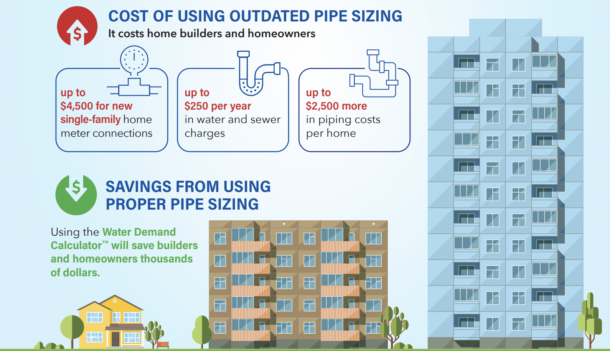
Arup’s study found that when the Water Demand Calculator is used for domestic water design for residential buildings instead of the Hunter’s Curve sizing methods, there are resulting operational energy and embodied carbon savings in all four of the use cases, as well as water savings in the non-circulating units. Water savings were demonstrated through minimized time to tap using the Water Demand Calculator sizing and range from 450 gallons to 71,000 gallons annually depending on the building size.
A single-family unit prototype showed annual water savings of 450 gallons, while high-rise residential buildings show savings in operational carbon between 73 and 84% for booster pumps and embodied carbon savings ranging from 20% to 41%. Using the Water Demand Calculator instead of the Hunter’s Curve method to size domestic water systems in high-rise residential buildings shows savings of operational carbon ranging from 2,000 to nearly 24,000 pounds of carbon dioxide per high-rise residential building, depending on grid emissions at the project site. Additionally, a reduction in pipe sizing allows for reduced heat loss through pipes.
”The Water Demand Calculator is a tool for its age,” IAPMO Vice President of Technical Services and Research Christoph Lohr, P.E., said. “With concerns of energy reduction and water savings being top of mind for many regions in the United States and the world, having the latest methodology to meet goals is vital. We greatly appreciate Arup providing IAPMO with a third-party evaluation of the potential for the Water Demand Calculator to help meet sustainability goals.”
The Water Demand Calculator is the first significant update for water pipe sizing in buildings since Hunter’s Curve was developed more than 80 years ago. The Water Demand Calculator predicts peak water demand for single- and multifamily dwellings and removes the need for assigning fixture units to plumbing fixtures and corresponding to Hunter’s probability curve. Instead, it directly calculates peak demand using algorithms based on the building size.
Contained within Appendix M of the 2021 and 2024 Uniform Plumbing Code (UPC®) and free to download, version 2.1 of the Water Demand Calculator addresses water quality issues attributed to lower flows in oversized premise plumbing while simultaneously using less water and energy, representing the most impactful innovation in pipe sizing in nearly a century. It is the result of a multiyear effort to develop a new statistically based pipe sizing method stemming from a need to address profound water safety and wasted water and energy concerns resulting from oversized water supply pipes in homes and buildings.
The entire Arup report may be viewed at https://iapmo.org/media/31469/iapmo_energy_savings_arup_report.pdf.
The new feature gives Text Request customers the ability to request, track, and respond to Google reviews seamlessly from Text Request Text Request, the industry-leading business messaging platform, announced today the release of its newest feature, Reviews — a review management solution that enables customers to request, track, and respond to reviews on Google directly from their Read more
The new feature gives Text Request customers the ability to request, track, and respond to Google reviews seamlessly from Text Request
How it works:
- Total number of reviews
- Average rating of reviews per platform, as well as average rating of all reviews
- Number of review requests sent
- Comparison data for organic reviews vs. those requested from Text Request
- A variety of data filtering options, including year-to-date, month-to-date, and custom date ranges
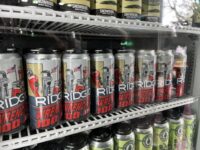
The limited-edition craft beer celebrates trade professionals and the RIDGID legacy RIDGID®, a part of Emerson’s professional tools portfolio, is celebrating its 100th anniversary with RIDGID Wrenched 100 IPA, a limited-edition anniversary beer. The brew, created in collaboration with Unplugged Brewing Company, pays tribute to the expert tradespeople who work hard and know how to Read more
The limited-edition craft beer celebrates trade professionals and the RIDGID legacy
RIDGID®, a part of Emerson’s professional tools portfolio, is celebrating its 100th anniversary with RIDGID Wrenched 100 IPA, a limited-edition anniversary beer. The brew, created in collaboration with Unplugged Brewing Company, pays tribute to the expert tradespeople who work hard and know how to unplug.
Unplugged is an Elyria-based craft brewery and worked closely with the RIDGID team to create the bold and steady brew – just like the brand that inspired it. “Our goal was to say thank you to the trade professionals who over the past 100 years have put their trust in our tools every day on jobsites around the world,” said Becky Brotherton, director of brand and marketing, RIDGID for Emerson. “Having a small, hardworking brewery in our own backyard allowed us to create something that was truly special.”
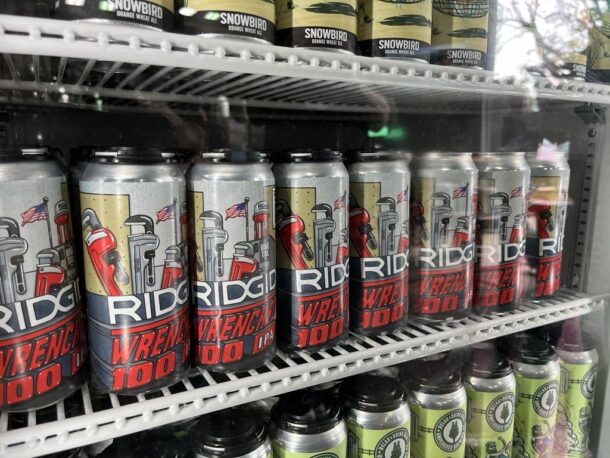
The specialty craft beer is available for purchase in select Northeast Ohio stores and online for direct-to-home shipping in 41 states through December. To purchase online, visit: rivalrybrews.com/products/ridgid-wrenched-100. Enjoy responsibly.
“RIDGID is an iconic name, recognized around the world, and we’re proud to help them celebrate this milestone anniversary,” said Carlos Lopez, owner of Unplugged Brewery. “As a small business owner, it’s been an honor to create this brew for a company that celebrates its customers in this special way.”
In addition to the RIDGID Wrenched 100 IPA, a limited edition RIDGID beer tap is also available to purchase for use or display. The tap is manufactured at RIDGID global headquarters in Elyria, Ohio, on the same production lines used to produce the brand’s legendary wrenches. It fits a 3/8″-16 body thread or can sit upright for display in a home or shop. Commemorative pint glasses, t-shirts, signs, and hats are also available at ridgidgear.com.
In 1923, the Ridge Tool Company invented the modern straight pipe wrench, introducing it to the world under their brand, RIDGID. Since then, every step forward has been taken with the tradesperson in mind. Today, RIDGID’s pipe wrench design is the best-selling pipe wrench in the world, and many of the wrenches that were sold back in the 1920s and 30s are still in use today.
 This year, RIDGID is celebrating 100 years of designing and building innovative tools trusted on jobsites around the world and handed down from generation to generation. To commemorate the occasion, RIDGID is spending 2023 celebrating the trades, their impact on our world, and the brand’s legacy.
This year, RIDGID is celebrating 100 years of designing and building innovative tools trusted on jobsites around the world and handed down from generation to generation. To commemorate the occasion, RIDGID is spending 2023 celebrating the trades, their impact on our world, and the brand’s legacy.
To learn more about the 100th anniversary, individuals are invited to visit RIDGID.com/100 or their social channels – @RIDGIDTools on Facebook, @RIDGIDTools on Instagram, and @RIDGIDTools on TikTok.
Emerson’s professional tools business, which includes RIDGID as well as the Greenlee® and Klauke® brands, provides the industry’s broadest portfolio of advanced, reliable tools and technologies for the mechanical, electrical and plumbing trades globally. Visit emerson.com/professionaltools for more information.
